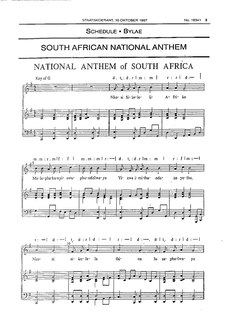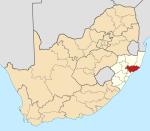
The national anthem of South Africa was adopted in 1997 and is a hybrid song combining new English lyrics with extracts of the 19th century hymn "Nkosi Sikelel' iAfrika" and the Afrikaans song "Die Stem van Suid-Afrika", which was formerly used as the South African national anthem from the late 1930s to the mid-1990s. The committee responsible for this new composition included Anna Bender, Elize Botha, Richard Cock, Dolf Havemann (Secretary), Mzilikazi Khumalo (Chairman), Masizi Kunene, John Lenake, Fatima Meer, Khabi Mngoma, Wally Serote, Johan de Villiers, and Jeanne Zaidel-Rudolph.

"Mungu ibariki Afrika" is the national anthem of Tanzania. It is a Swahili language version of Enoch Sontonga's popular hymn "Nkosi Sikelel' iAfrika".

The Afrika Korps or German Africa Corps was the German expeditionary force in Africa during the North African Campaign of World War II. First sent as a holding force to shore up the Italian defense of their African colonies, the formation fought on in Africa, under various appellations, from March 1941 until its surrender in May 1943. The unit's best known commander was Field Marshal Erwin Rommel.

The Universal Zulu Nation is an international hip hop awareness group formed by and formerly led by hip hop artist Afrika Bambaataa.

The Ossewabrandwag (OB) was an anti-British and pro-German organisation in South Africa during World War II, which opposed South African participation in the war. Pro-German Afrikaners formed the Ossewabrandwag in Bloemfontein on 4 February 1939.
Ismail Joubert, commonly known as Tatamkhulu Afrika, which is Xhosa for Grandfather Africa, was a South African poet and writer. His first novel, Broken Earth was published when he was seventeen, but it was over fifty years until his next publication, a collection of verse entitled Nine Lives.

"Die Stem van Suid-Afrika", also known as "The Call of South Africa" or simply "Die Stem", is a former national anthem of South Africa. There are two versions of the song, one in English and the other in Afrikaans, which were used during much of the apartheid era. It was the sole national anthem from 1957 to 1994, and shared co-national anthem status with "God Save the King/Queen" from 1938 to 1957. After the end of apartheid in the early 1990s, it was retained as a co-national anthem along with "Nkosi Sikelel' iAfrika" from 1994 to 1997, when a new hybrid song incorporating elements of both songs was adopted as the country's new national anthem, which is still in use today.

"Nkosi Sikelel' iAfrika" is a hymn originally composed in 1897 by Enoch Sontonga, a Xhosa clergyman at a Methodist mission school near Johannesburg. The song became a pan-African liberation song and versions of it were later adopted as the national anthems of five countries in Africa including Zambia, Tanzania, Namibia and Zimbabwe after independence. Zimbabwe and Namibia have since adopted new compositions for their national anthems. The song's melody is currently used as the national anthem of Tanzania and the national anthem of Zambia. In 1994, Nelson Mandela decreed that the verse be embraced as a joint national anthem of South Africa, with a revised version including elements of "Die Stem" adopted in 1997.

The Republic of New Afrika (RNA), founded in 1968 as the Republic of New Africa (RNA), is a black nationalist organization and black separatist movement popularized by Black freedom fighter groups in the United States. The larger New Afrika movement in particular has three goals:
The Felixton College is a small school based 15 minutes outside of Empangeni, KwaZulu-Natal, South Africa, in the village of Felixton. It caters from junior school to high school. The Felixton College is a member of the Independent Examinations Board (IEB), a South African independent assessment agency which offers examinations for various client schools. The school offers numerous sports and after school activities. Alongside extensive playing fields, the school have a swimming pool, tennis and squash courts and astro turf, and a golf course provided by the Felixton Country Club.

Pofadder is a very small town in the Northern Cape province of South Africa. In spite of its small size it is an important local centre in the region known in South Africa as Bushmanland. The surrounding districts are arid, sparsely populated, rugged and picturesque. There is little in the way of cropping and local farmers run sheep or goats for a living. As a tourist destination it is not sufficiently spectacular to rival the spring flowers of the coastal regions of Namaqualand, but it has its attractions for biologists and conservationists and those with an interest in its remarkable diversity of often-tiny xerophytes and animal life.

AfrikaBurn is an official Burning Man regional event, held annually in the Tankwa Karoo National Park in South Africa since 2007. It is centred on the construction of temporary artworks in a semi-desert environment, some of which are burnt towards the end of the event. Many attendees wear elaborate costumes and create decorated "mutant vehicles".

German South West Africa was a colony of the German Empire from 1884 until 1919. With a total area of 835,100 km², it was one and a half times the size of the mainland German Empire in Europe at the time. The colony had a population of around 2,600 Germans.

The White Liberation Movement was a small but notorious South African neo-Nazi organisation which became infamous after being banned under the Apartheid regime, the first right-wing organisation to be so banned. It regarded itself as the most far-right organisation in South Africa.

Cecil Sebastian Afrika is a South African rugby sevens player for the South Africa national team, where he plays at flyhalf. He was a member of the South African Sevens team that won a bronze medal at the 2016 Summer Olympics.

Camperdown is a settlement in Umgungundlovu District Municipality in the KwaZulu-Natal province of South Africa. Town some 60km by road north-west of Durban. Laid out in 1865 on the farm Camperdown, named to commemorate the victory of the British navy under Admiral Adam Duncan over the Dutch fleet under Admiral Jan Willem de Winter in October 1797.

Upingtonia, or the Republic of Upingtonia, was a short-lived Boer republic in the area of present-day Namibia. Declared on 20 October 1885, in 1886 it changed its name to Lijdensrust. In 1887 it was merged into German South-West Africa.

Frere is a town in Inkosi Langalibalele Local Municipality in the KwaZulu-Natal province of South Africa. The city is named for Sir Henry Bartle Frere, Governor of Cape Colony from 1877 to 1880. The city was for a time the headquarters of Sir Redvers Buller during the Second Boer War. The town is 25 km east of Winterton.

9 South African Infantry Battalion is a motorised infantry unit of the South African Army, designated seaborne.

In 1992, South Africa played a rugby union test match against New Zealand, which later became known as the Return Test. It was a rugby union test match between the South African national rugby union team and New Zealand national rugby union team at Ellis Park Stadium in Johannesburg on 15 August 1992. It was named as the Return Test as it was South Africa's first test match since the International Rugby Board (IRB) had banned them due to apartheid.



















